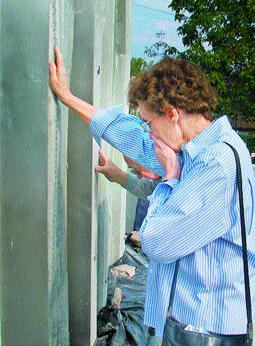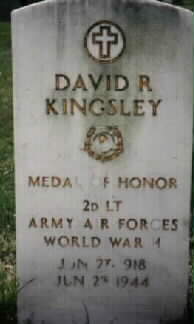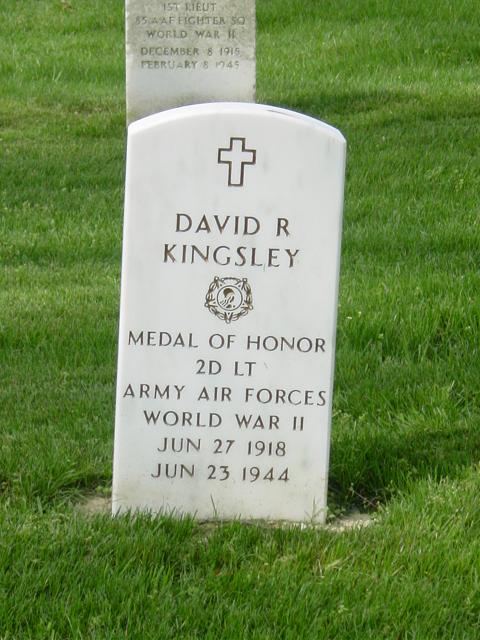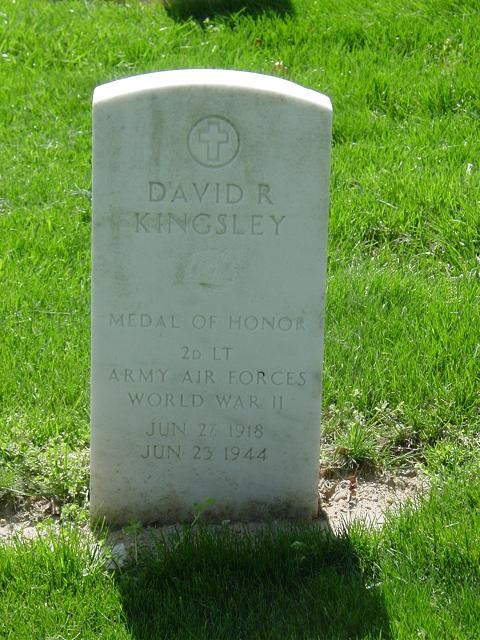Born at Portland, Oregon, June 27, 1918, he earned the Medal of Honor during World War II, where he served as a bombadier on a B-17 on a raid into Romania on June 23, 1944. During the mission the aircraft was badly damaged by enemy fire and forced to drop out of the formation. The pilot continued on to the target, the Ploesti Oil Fields, and there he dropped his bombs, severely damaging the installation. The aircraft was unable to keep up with the formation on the return trip and was attacked by enemy aircraft, during which the plane was further damaged and the tail gunner badly wounded. Kinglsley gave aid to the gunner and then went to give aid to the ball gunner who had also been wounded. The pilot gave the order to bail out but Kingsley found that the tail gunner’s parachute was mising. He placed his own chute on the wounded man and then he helped the wounded men bail out of the burning plane. The last sight of him was as he stood on the bomb bay catwalk while the plane flew on auto pilot until it crashed a few minutes later.
His body was subsequently located and returned to the U.S. where it was buried in Section 34 of Arlington National Cemetery.
KINGSLEY, DAVID R
- 2ND LT USA AAF 9TH AF, WWII
- VETERAN SERVICE DATES: Unknown
- DATE OF INTERMENT: 07/06/1949
- BURIED AT: SECTION 34 SITE 4786
- ARLINGTON NATIONAL CEMETERY
KINGSLEY, DAVID R. (Air Mission)
Rank and organization: Second Lieutenant, U.S. Army Air Corps, 97th Bombardment Group, 15th Air Force. Place and date: Ploesti Raid, Rumania, 23 June 1944. Entered service at. Portland, Oregon. Birth: Oregon. G.O. No.: 26, 9 April 1945.
Citation:
For conspicuous gallantry and intrepidity in action at the risk of life above and beyond the call of duty, 23 June 1944 near Ploesti, Rumania, while flying as bombardier of a B17 type aircraft.
On the bomb run 2d Lt. Kingsley’s aircraft was severely damaged by intense flak and forced to drop out of formation but the pilot proceeded over the target and 2d Lt. Kingsley successfully dropped his bombs, causing severe damage to vital installations. The damaged aircraft, forced to lose altitude and to lag behind the formation, was aggressively attacked by 3 ME-109 aircraft, causing more damage to the aircraft and severely wounding the tail gunner in the upper arm. The radio operator and engineer notified 2d Lt. Kingsley that the tail gunner had been wounded and that assistance was needed to check the bleeding. 2d Lt. Kingsley made his way back to the radio room, skillfully applied first aid to the wound, and succeeded in checking the bleeding. The tail gunner’s parachute harness and heavy clothes were removed and he was covered with blankets, making him as comfortable as possible. Eight ME-109 aircraft again aggressively attacked 2d Lt. Kingsley’s aircraft and the ball turret gunner was wounded by 20mm. shell fragments. He went forward to the radio room to have 2d Lt. Kingsley administer first aid. A few minutes later when the pilot gave the order to prepare to bail out, 2d Lt. Kingsley immediately began to assist the wounded gunners in putting on their parachute harness. In the confusion the tail gunner’s harness, believed to have been damaged, could not be located in the bundle of blankets and flying clothes which had been removed from the wounded men. With utter disregard for his own means of escape, 2d Lt. Kingsley unhesitatingly removed his parachute harness and adjusted it to the wounded tail gunner. Due to the extensive damage caused by the accurate and concentrated 20mm. fire by the enemy aircraft the pilot gave the order to bail out, as it appeared that the aircraft would disintegrate at any moment. 2d Lt. Kingsley aided the wounded men in bailing out and when last seen by the crewmembers he was standing on the bomb bay catwalk. The aircraft continued to fly on automatic pilot for a short distance, then crashed and burned. His body was later found in the wreckage. 2d Lt. Kingsley by his gallant heroic action was directly responsible for saving the life of the wounded gunner.
Friday, October 22, 2004
The gift of life
By Todd Kepple
Courtesy of the Herald and the News of Oregon

‘Second Lieutenant Kingsley made his way back to the radio room, skillfully applied first aid to the wound, and succeeded in checking the bleeding. …
A few minutes later when the pilot gave the order to prepare to bail out, Second Lieutenant Kingsley immediately began to assist the wounded gunners.’
– Medal of honor citation
The Opissonya was struggling to maintain altitude as it flew away from its bombing target at Ploesti, Romania.
The B-17 Flying Fortress carrying Second Lieutenant David Kingsley and eight other members of the U.S. Army Air Force had dropped its payload on an oil storage facility, but had sustained damage from an anti-aircraft shell.
Its number 1 engine was out, and the plane had become separated from the formation of other bombers, leaving it vulnerable to enemy fighters. At some point, cables giving the pilot control over the tail section of the plane were severed.
Making matters worse, German ME-109 fighter planes scrambled from an air field at Karlovo, Bulgaria, and pursued the crippled Opissonya.
As the fighters attacked from the rear, 20-millimeter cannon fire hit tail gunner Mike Sullivan, injuring his head and shoulder, and damaging his parachute harness.
Sullivan crawled from the tail to the mid-section of the plane. Kingsley was asked to dress his wounds.
Kingsley removed the damaged parachute from Sullivan, and managed to stem the flow of blood from his wounded arm.
Kingsley’s bomber, the Opissonya, sits at a base before its fateful final mission.
In an effort to keep the faltering plane aloft, the crew began throwing out unnecessary equipment, but the damage was too severe. The pilot struggled to maintain control, but knew that if the plane began a nosedive, it would be increasingly difficult for its crew to escape.
He signaled for the crew to bail out.
With Sullivan’s parachute damaged, and perhaps lost in the confusion, Kingsley took his own parachute off and strapped it on Sullivan. He then helped Sullivan to the bomb bay, and made sure Sullivan jumped safely.
“Carrying me in his arms, Lieutenant Kingsley struggled to get me through the door into the bomb bay,” Sullivan told the Oregonian newspaper the following year, when Kingsley was posthumously awarded the Medal of Honor.
“He told me to be sure and pull the rip cord after I had cleared the ship,” Sullivan continued.
“I did and as I was floating down I saw the Fort fall off and go into a spin. It crashed, exploded and burned.
“The last time I saw Lieutenant Kingsley, he was standing on the catwalk over the open bomb bay doors.”
All eight crewmen who jumped from the plane made it to the ground safely. Seven were captured and held as prisoners of war, while one was hidden by Bulgarians sympathetic to the allied cause.
Sullivan, circa 1995 ‘Carrying me in his arms, Lieutenant Kingsley struggled to get me through the door into the bomb bay. … The last time I saw Lieutenant Kingsley, he was standing on the catwalk over the open bomb bay doors.’
The B-17 crashed near the village of Suhozem, a tiny remote village.
A Bulgarian air commander on the ground watched the plane go down and went to the crash site. He found Kingsley’s body in the cockpit.
Witnesses on the ground said the plane circled before coming down, indicating Kingsley may have tried to save his own life by making a crash landing in a field.
Bulgarian villagers buried Kingsley in a makeshift grave. He was later reinterred at Arlington National Cemetery.
Two months after the crash of the Opissonya, Russian forces captured the heavily damaged oil field at Ploesti. The captured members of the Opissonya were held as prisoners until being released on September 10, 1944.
Kingsley was posthumously awarded the Medal of Honor on May 4, 1945. The award was presented to his brother, Navy Pharmacist’s Mate First Class Thomas Kingsley, in a ceremony at St. Michael’s Catholic Church in Portland. The ceremony was followed by a high mass.
The Klamath Falls municipal airport, which had served as a naval air station during World War II, was taken over by the Air Force in 1957. It was named Kingsley Field on July 3 of that year.
The U.S. Department of Defense closed its base at Kingsley Field in 1978, but the Oregon Air National Guard reopened the facility in 1980.
Three members of the Opissonya crew gathered for a reunion at Kingsley Field in June 1995. They were pilot Edwin “Andy” Anderson, ball turret gunner Stanley Kmiec, and tail gunner Mike Sullivan, whose life was saved by Kingsley.
Kmiec is the only member of the crew still living.
Over the past 60 years, the Kingsley family cherished fond memories of a brother and the military honored him as a hero.
But there was also mourning in Bulgaria, which became a satellite nation of the Soviet Union. While the story of Kingsley’s sacrifice was memorialized in America, it’s rarely mentioned that the crash killed members of a Bulgarian family on the ground.
Villagers who knew the family are expected to be among those attending the dedication of a memorial Saturday at the tiny village of Suhozem, Bulgaria.


Michael Robert Patterson was born in Arlington and is the son of a former officer of the US Army. So it was no wonder that sooner or later his interests drew him to American history and especially to American military history. Many of his articles can be found on renowned portals like the New York Times, Washingtonpost or Wikipedia.
Reviewed by: Michael Howard

